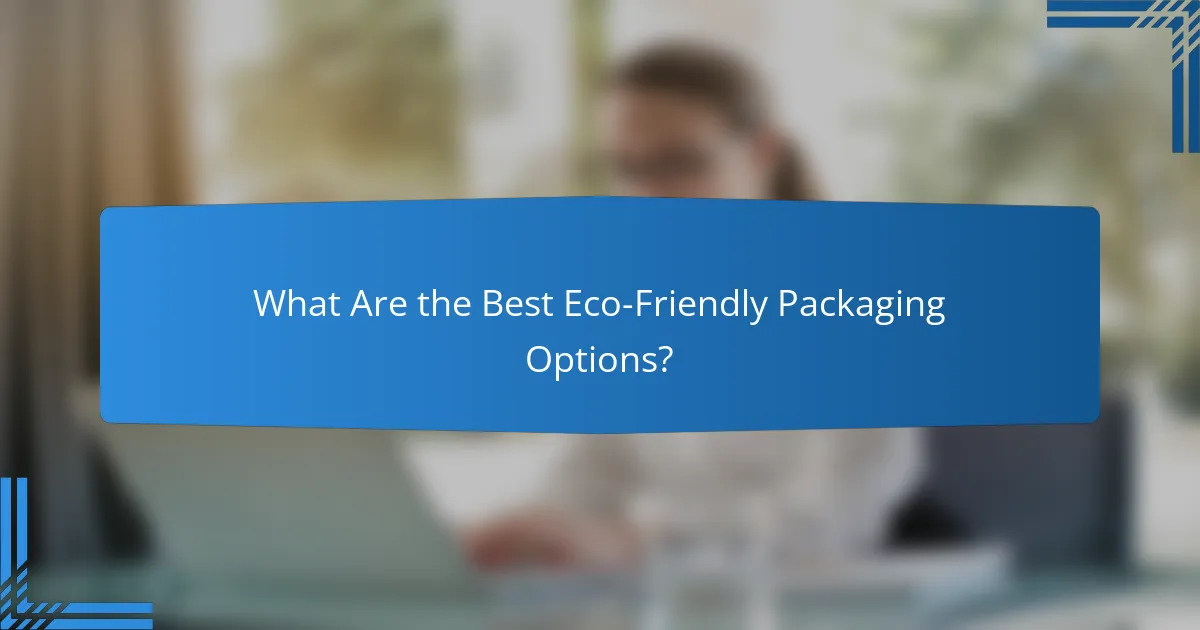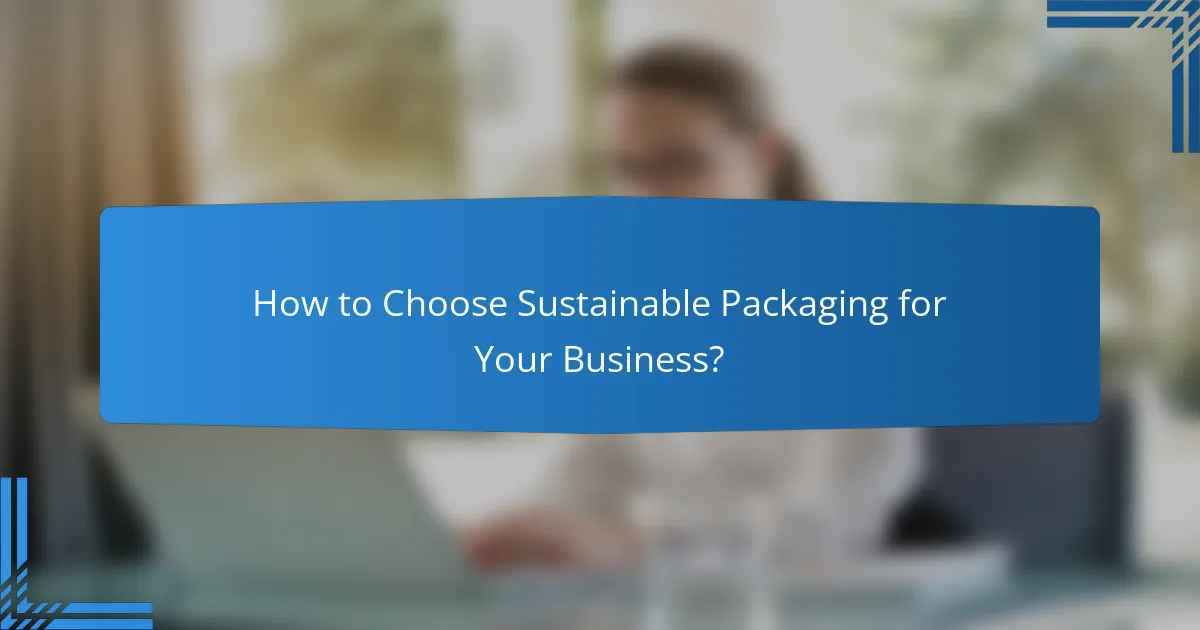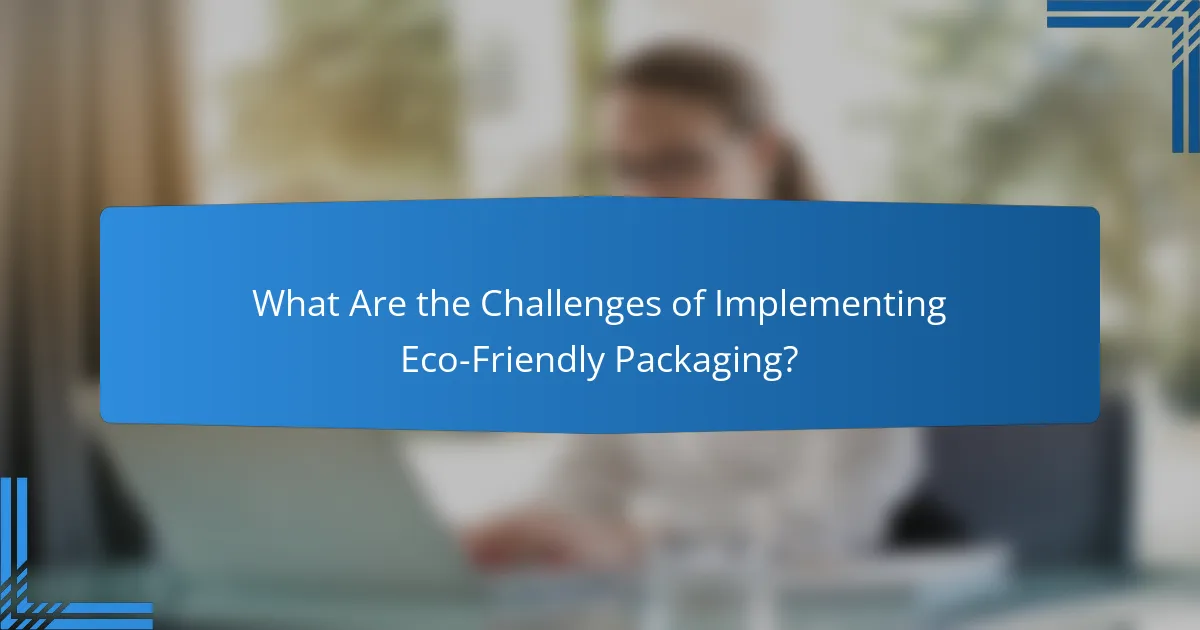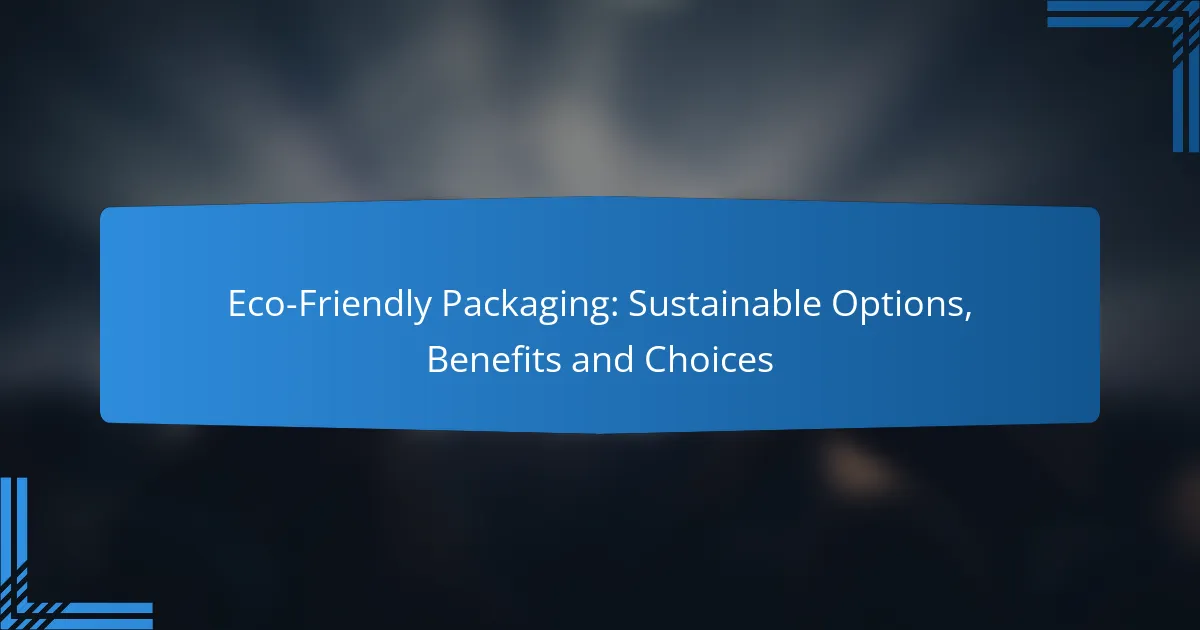Eco-friendly packaging is an essential consideration for businesses looking to reduce their environmental footprint while meeting consumer demand for sustainability. Options such as biodegradable materials, recycled paper, and plant-based plastics not only protect products but also enhance brand reputation. By prioritizing sustainable choices, companies can align with eco-conscious values and potentially achieve cost savings in the long run.

What Are the Best Eco-Friendly Packaging Options?
The best eco-friendly packaging options include biodegradable materials, recycled paper products, plant-based plastics, glass containers, and compostable packaging. These alternatives minimize environmental impact while providing effective solutions for product protection and presentation.
Biodegradable Materials
Biodegradable materials break down naturally over time, reducing waste in landfills. Common examples include materials made from starch, cellulose, or other organic substances. When choosing biodegradable options, consider their composting conditions and the time required for decomposition, which can range from a few months to several years.
Look for certifications such as ASTM D6400 or EN 13432 to ensure the material meets specific biodegradability standards. Avoid products that may not decompose in typical landfill conditions, as they could contribute to pollution.
Recycled Paper Products
Recycled paper products are made from post-consumer waste and help reduce deforestation. These products can include boxes, bags, and wrapping paper, which are often just as sturdy as their virgin counterparts. When selecting recycled paper, check the percentage of recycled content, aiming for at least 30% to make a significant impact.
Consider using unbleached or minimally processed recycled paper to further decrease environmental harm. Additionally, look for certifications like the Forest Stewardship Council (FSC) to ensure sustainable sourcing.
Plant-Based Plastics
Plant-based plastics, often derived from corn or sugarcane, serve as a sustainable alternative to traditional petroleum-based plastics. These materials can be used for various applications, including bottles, containers, and packaging films. While they can reduce reliance on fossil fuels, their biodegradability can vary, so it’s essential to research specific products.
Be aware that not all plant-based plastics are compostable; check for certifications like BPI or OK Compost to confirm their environmental credentials. Additionally, consider the energy and resources required for their production, which can impact their overall sustainability.
Glass Containers
Glass containers are a durable and recyclable option for packaging. They can be reused multiple times and are fully recyclable without losing quality. While glass is heavier and more fragile than other materials, it offers excellent protection for food and beverages, making it a popular choice for eco-conscious brands.
When using glass, consider the energy costs associated with production and transportation. Opt for locally sourced glass products to minimize carbon footprint and support local economies.
Compostable Packaging
Compostable packaging is designed to break down into organic matter in a composting environment, enriching the soil. This type of packaging can include materials like PLA (polylactic acid) and certain types of paper. Ensure that the compostable packaging is suitable for your composting system, as some require industrial composting facilities to decompose effectively.
Look for certifications such as the Compostable Products Institute (CPI) to verify compostability claims. Avoid mixing compostable packaging with non-compostable waste, as this can contaminate the composting process and reduce its effectiveness.

What Are the Benefits of Eco-Friendly Packaging?
Eco-friendly packaging offers numerous advantages, including reduced environmental impact, improved brand reputation, compliance with regulations, and potential cost savings. These benefits make it an attractive choice for businesses aiming to enhance sustainability while appealing to environmentally conscious consumers.
Reduced Environmental Impact
Using eco-friendly packaging significantly lowers the environmental footprint of products. Materials such as biodegradable plastics, recycled paper, and plant-based options help minimize waste and pollution. By choosing sustainable materials, companies contribute to resource conservation and reduce landfill contributions.
For example, switching from traditional plastic to compostable packaging can cut down on plastic waste, which is crucial given that millions of tons of plastic end up in oceans each year. Companies can also consider local sourcing to further reduce transportation emissions.
Enhanced Brand Image
Adopting eco-friendly packaging can greatly enhance a brand’s image. Consumers are increasingly favoring companies that prioritize sustainability, which can lead to increased customer loyalty and market share. Brands that communicate their commitment to the environment often attract a broader audience.
For instance, businesses that use recyclable or compostable materials can promote these practices in their marketing, appealing to eco-conscious shoppers. This positive perception can differentiate a brand in a crowded marketplace, leading to higher sales and customer retention.
Compliance with Regulations
Many regions are implementing stricter regulations regarding packaging waste and sustainability. Eco-friendly packaging helps businesses comply with these laws, avoiding potential fines and enhancing their reputation as responsible corporate citizens. Regulations may include bans on single-use plastics or requirements for recyclable materials.
Staying ahead of regulatory changes by adopting sustainable practices can also provide a competitive edge. Companies that proactively implement eco-friendly packaging are better positioned to adapt to future legislation, ensuring long-term viability.
Cost Savings Over Time
While the initial investment in eco-friendly packaging may be higher, businesses often experience cost savings in the long run. Sustainable materials can reduce disposal costs, and many eco-friendly options are designed to be lighter, which can lower shipping expenses. Additionally, using recycled materials can be more cost-effective than sourcing virgin materials.
Companies should evaluate their packaging lifecycle to identify potential savings. For example, reducing packaging size not only cuts material costs but also decreases shipping fees. Implementing a sustainable packaging strategy can lead to significant financial benefits over time.

How to Choose Sustainable Packaging for Your Business?
Choosing sustainable packaging involves selecting materials and processes that minimize environmental impact while meeting your business needs. Focus on eco-friendly materials, lifecycle assessments, and customer preferences to make informed decisions.
Assess Material Sources
Start by evaluating the origins of your packaging materials. Look for renewable resources, such as bamboo, recycled paper, or bioplastics, which can significantly reduce your carbon footprint. Ensure that suppliers adhere to sustainable practices, such as responsible forestry or ethical sourcing.
Consider certifications like FSC (Forest Stewardship Council) for paper products or compostability standards for bioplastics. These certifications can enhance your brand’s credibility and appeal to environmentally conscious consumers.
Evaluate Lifecycle Impact
Assess the entire lifecycle of your packaging, from production to disposal. Calculate the energy consumption, emissions, and waste generated at each stage. This holistic view helps identify areas for improvement and can guide you towards more sustainable options.
Utilize tools like life cycle assessment (LCA) software to compare different materials and processes. Aim for packaging that is not only recyclable but also minimizes environmental harm during production and transportation.
Consider Customer Preferences
Your customers’ values play a crucial role in choosing sustainable packaging. Conduct surveys or focus groups to understand their preferences regarding eco-friendly options. Many consumers are willing to pay a premium for products that use sustainable packaging.
Highlight the sustainability aspects of your packaging on your product labels and marketing materials. Transparency about your efforts can build trust and loyalty among customers who prioritize environmental responsibility.

What Are the Challenges of Implementing Eco-Friendly Packaging?
Implementing eco-friendly packaging presents several challenges that businesses must navigate. These include higher initial costs, limited availability of sustainable materials, and the need for consumer education to drive acceptance and understanding.
Higher Initial Costs
One of the primary challenges of eco-friendly packaging is the higher initial costs associated with sustainable materials. Businesses may face expenses that are significantly greater than traditional packaging options, which can deter small companies from making the switch.
For instance, biodegradable or compostable materials often cost more per unit than plastic or Styrofoam. Companies should consider these costs as an investment in long-term sustainability and brand reputation, as consumers increasingly favor environmentally responsible practices.
Limited Availability of Materials
The availability of eco-friendly packaging materials can be a significant hurdle. Many sustainable options are still in the early stages of production and distribution, leading to supply chain issues and limited choices for businesses.
For example, while recycled paper products are widely available, alternatives like plant-based plastics may not be as easily sourced. Companies should establish relationships with suppliers who specialize in sustainable materials to ensure a consistent supply.
Consumer Education Needs
Educating consumers about the benefits and proper disposal of eco-friendly packaging is crucial for its success. Many customers may not understand how to recycle or compost these materials, leading to contamination and waste.
Businesses can address this by providing clear information on packaging labels and through marketing campaigns. Engaging consumers with educational content about the environmental impact of their choices can foster a more supportive market for sustainable packaging solutions.
